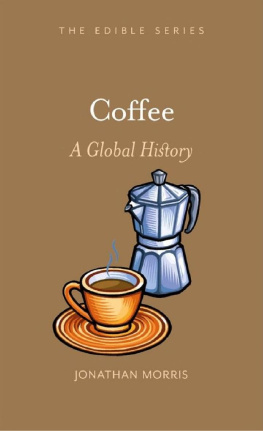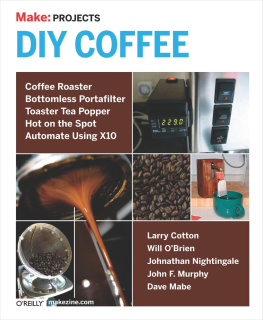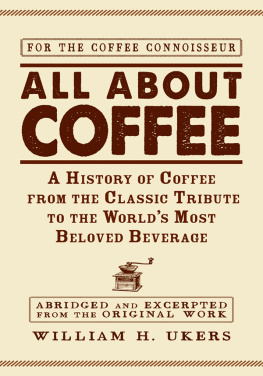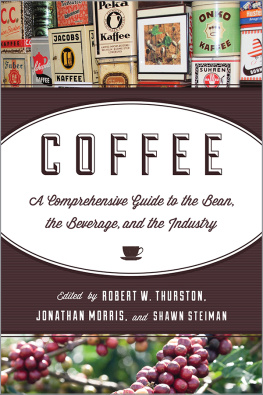
COFFEE

Edible
Series Editor: Andrew F. Smith
EDIBLE is a revolutionary series of books dedicated to food and drink that explores the rich history of cuisine. Each book reveals the global history and culture of one type of food or beverage.
Already published
Apple Erika Janik Banana Lorna Piatti-Farnell
Barbecue Jonathan Deutsch and Megan J. Elias Beef Lorna Piatti-Farnell
Beer Gavin D. Smith Berries Heather Arndt Anderson
Brandy Becky Sue Epstein Bread William Rubel
Cabbage Meg Muckenhoupt Cake Nicola Humble
Caviar Nichola Fletcher Champagne Becky Sue Epstein
Cheese Andrew Dalby Chillies Heather Arndt Anderson
Chocolate Sarah Moss and Alexander Badenoch
Cocktails Joseph M. Carlin Coffee Jonathan Morris
Corn Michael Owen Jones Curry Colleen Taylor Sen
Dates Nawal Nasrallah Doughnut Heather Delancey Hunwick
Dumplings Barbara Gallani Edible Flowers Constance L. Kirker
and Mary Newman Eggs Diane Toops Fats Michelle Phillipov
Figs David C. Sutton Game Paula Young Lee
Gin Lesley Jacobs Solmonson Hamburger Andrew F. Smith
Herbs Gary Allen Herring Kathy Hunt Honey Lucy M. Long
Hot Dog Bruce Kraig Ice Cream Laura B. Weiss Lamb Brian Yarvin
Lemon Toby Sonneman Lobster Elisabeth Townsend
Melon Sylvia Lovegren Milk Hannah Velten Moonshine Kevin R. Kosar
Mushroom Cynthia D. Bertelsen Nuts Ken Albala Offal Nina Edwards
Olive Fabrizia Lanza Onions and Garlic Martha Jay
Oranges Clarissa Hyman Oyster Carolyn Tillie Pancake Ken Albala
Pasta and Noodles Kantha Shelke Pickles Jan Davison Pie Janet Clarkson
Pineapple Kaori OConnor Pizza Carol Helstosky
Pomegranate Damien Stone Pork Katharine M. Rogers
Potato Andrew F. Smith Pudding Jeri Quinzio Rice Renee Marton
Rum Richard Foss Salad Judith Weinraub Salmon Nicolaas Mink
Sandwich Bee Wilson Sauces Maryann Tebben Sausage Gary Allen
Seaweed Kaori OConnor Shrimp Yvette Florio Lane
Soup Janet Clarkson Spices Fred Czarra Sugar Andrew F. Smith
Sweets and Candy Laura Mason Tea Helen Saberi Tequila Ian Williams
Truffle Zachary Nowak Vodka Patricia Herlihy Water Ian Miller
Whiskey Kevin R. Kosar Wine Marc Millon
Coffee
A Global History
Jonathan Morris
REAKTION BOOKS
My parents, Anne and Graham Morris, taught me little about coffee, but much about life, and this book is dedicated to them with love.
Published by Reaktion Books Ltd
Unit 32, Waterside
4448 Wharf Road
London N 1 7 UX, UK
www.reaktionbooks.co.uk
First published 2019
Copyright Jonathan Morris 2019
All rights reserved
No part of this publication may be reproduced, stored in a retrieval system, or transmitted, in any form or by any means, electronic, mechanical, photocopying, recording or otherwise, without the prior permission of the publishers
Page references in the Photo Acknowledgements and
Index match the printed edition of this book.
Printed and bound in China by 1010 Printing International Ltd
A catalogue record for this book is available from the British Library
e ISBN 9781789140262
Contents

Introduction

Coffee is a global beverage. It is grown commercially on four continents, and consumed enthusiastically in all seven: Antarctic scientists love their coffee. There is even an Italian espresso machine on the International Space Station. Coffees journey has taken it from the forests of Ethiopia to the fincas of Latin America, from Ottoman coffee houses to third wave cafs, and from the coffee pot to the capsule machine.
This book is the first global history of coffee written by a professional historian. It explains how the world acquired a taste for coffee, yet why coffee tastes so different throughout the world. From the beverages first appearance among Sufi sects in fifteenth-century Arabia, through to the specialty coffee consumers of twenty-first-century Asia, this book discusses who drank coffee, why and where they drank it, how they prepared it and what it tasted like. It identifies the regions and ways in which coffee was grown, who worked the farms and who owned them, and how the beans were processed, traded and transported. It analyses the businesses behind coffee the brokers, roasters and machine manufacturers and dissects the geopolitics behind the structures linking producers to consumers.
Regional Distribution of Global Coffee Production (%)
| Africa and Arabia | Caribbean | Asia | Latin America |
| 1700 | 100 | 0 | 0 | 0 |
| 1830 | 2 | 38 | 28 | 32 |
| 19001904 | 1 | 4 | 4 | 91 |
| 197074 | 30 | 3 | 6 | 61 |
| 201115 | 9 | 1 | 32 | 58 |
The distinctions between commodity and specialty coffee, and the ways these determine the transformations that coffee undergoes from seed to cup, are the subject of the opening chapter of the book.
The history of coffee is divided into five eras. Coffee first served as the Wine of Islam, cultivated on Yemens mountain terraces and traded among the Muslim peoples around the shores of the Indian Ocean and the Red Sea. Europeans turned it into a colonial good during the eighteenth century, compelling serfs and slaves to plant it in places as far apart as Java and Jamaica.
Coffee was transformed into an industrial product in the second half of the nineteenth century as the rapid expansion of output in Brazil nurtured the development of a mass consumer market in the United States. After the 1950s, coffee became a global commodity as Africa and Asia regained a significant share of world trade by planting Robusta, a hardier, but harsher-tasting species, used in cheaper blends and soluble products. A movement to recast coffee as a specialty beverage began as a reaction against commodification at the end of the twentieth century. Its transnational success may result in the fifth era of coffee history.
Steampunk coffee machine. This unique machine was built from a variety of upcycled components to create a talking piece for the 2017 London Coffee Festival. At its heart is a cold drip coffee maker that takes eight hours to produce 1 litre of coffee. |  |
The coffee trade operates with a multitude of definitions and units of measurement. Historical data sets are rarely comparable, so rather than imposing a false unity, the book presents statistics in the form they were originally produced. Macro comparisons, calculated using multiple sources, are intended to convey the direction and scale of change, and numbers should not be regarded as definitive.
Grab a cup, turn the page, and enjoy your journey through coffees global history.

The anatomy and morphology of the coffee plant.
Seed to Cup

Next page

















